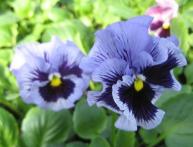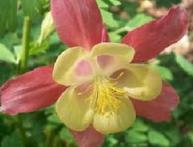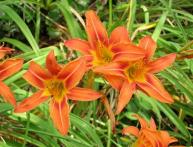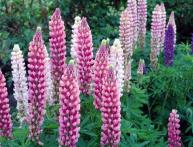Beautiful lilies in the garden, growing and caring for them
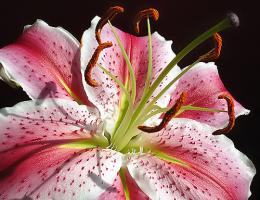
In terms of beauty and popularity, lilies are hardly inferior to the queen of flowers - the rose. In Russia, lilies began to be grown en masse by order of Peter I. They decorated gardens and parks, and they bloomed in front gardens. Elegant and fragrant flowering of garden lilies and currently attracts the attention of many gardeners who are excited about the idea of \u200b\u200bgrowing these flowers.
Not all of them know where to start growing lilies, which varieties of lilies are easy to grow and care for, and which ones require extra care. Before purchasing bulbs, you need to have a general understanding of caring for and planting lilies in the garden.
Content:
What types of lilies are there, general description
All lilies are united into one genus Lily of the Liliaceae family. Their life form is perennial herbaceous plants that form a bulb. Lily bulbs consist of lower leaves that are layered on top of each other. Bulbs lilies are light, most often white, yellow or pink. The stem is straight and slightly branched. It is a continuation of the bottom of the lily bulb. Lilies reproduce by seeds and bulbs.
When propagated by seed, a small bulb is formed in the first year. It increases in size over several years and the first flowers may appear after three years or after a longer period. Almost all lilies have sessile leaves. These plants are capable of forming small bulbs in the corners of the leaves, which have roots and, falling off, they immediately take root.
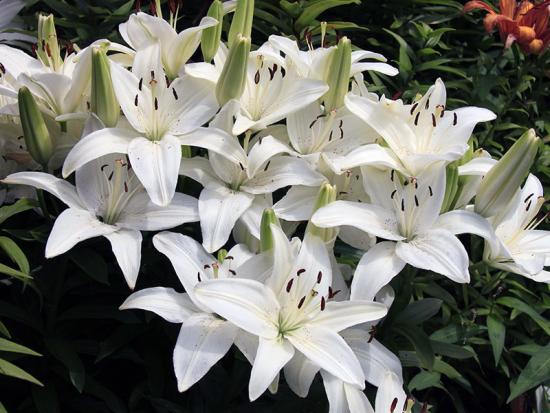
Most lilies have large perianths. They are formed by six petals. The shape of the flowers is like a funnel or a large bell. Some petals are bent back. The fruits of lilies are a capsule, the seeds are flat and dense. In total, the genus contains approximately one hundred species. Most of them grow in Europe and Asia; there are several species on the North American continent. About 30 species and many varieties and hybrids are cultivated in floriculture. The following are especially popular:
- Asian hybrids, they are the most hardy and unpretentious
- oriental hybrids, distinguished by large and very large flowers
- tubular hybrids, there are varieties with tall stems up to 2 m, there are new miniature varieties up to 30 cm in height
Breeding work to create new varieties is going on very intensively in many European countries and in the USA. All species have general requirements for cultivation and their own characteristics.
Planting lilies
The most convenient way to propagate lilies is with bulbs. The process begins with choosing a location in the garden. Most lilies prefer sunny, sheltered places from the wind. If possible, it is necessary to create such conditions so that the inflorescences are in the sun and the root system is protected from overheating. This can be done by planting low-growing plants nearby:
- bell
- viola
- cornflower
- Afila peas
- day-lily
Curly lilies feel good in partial shade. The soil for all lilies is light, well-drained and dries quickly. It is better to plant them on a small hill where the water does not stagnate. If, however, it is not possible to select an area with light soil for lilies, then sand is added to the clay soil. The application rate is one cubic meter of sand per square meter of land.If the area has sandy soil, you can add peat to improve it.
Video about lilies:
Taking into account the fact that lilies grow in one place for many years, it is advisable to add organic matter, compost or rotted manure to the soil. The norm is one - two buckets per square meter. meter. You can complete fertilizing the soil for lilies with a phosphorus-potassium mixture, one hundred grams per square meter is enough. meter. All fertilizers are applied under deep digging, up to 40 cm. If you take care of the soil fertility before planting, then in the first three years you don’t have to apply any other fertilizers to the lilies.
If for some reason this was not done, feed Lilies need to be applied at least twice per season, starting from the first year. An important point is the acidity of the soil. Slightly alkaline, neutral or, in extreme cases, slightly acidic soil is suitable. In acidic soils you need to add chalk or ash, at least 200 grams per square meter. meter. Bulbs can be planted in both spring and autumn. In spring they are planted in May, in autumn - in August or September. It is better to start with Asiatic lilies; they tolerate transplantation well at any time of the year, although spring planting can be recommended for most regions.
For large bulbs, the depth of the hole is approximately 15 cm, for small ones - 8 cm. A sand cushion is poured onto the bottom. Before embedding in the ground, the bulb is soaked in a strong solution of potassium permanganate for one hour. The distance between the bulbs is from 25 to 50 cm. Lilies look most impressive in small groups, 3-5 plants together. If planting occurs in the fall, then cover everything on top with foliage, and in the spring the protective layer is removed. In order for lilies to bloom regularly and luxuriantly, they need some care.
Caring for lilies

Most lilies grow and bloom well under the most normal conditions. care, which comes down to the main agrotechnical measures:
- weeding
- watering
- loosening
- feeding
Weeds under young lilies need to be removed regularly; under mature, strong plants there are fewer weeds and they need weeding less often. The first spring watering can be done when it becomes warmer outside + 10 degrees, and green cones appear above the surface. At the same time, loosening can be done. Loosen very carefully, without damaging the hatched greenery. At the same time, you can plant or sow ground cover plants to protect the lily roots from overheating in the sun.
It is recommended to sow viola, it prevents the development of fungal diseases. During the period of bud formation and flowering, plants need to be watered regularly. To do this, it is more convenient to take a watering can with a long narrow spout so that water can be applied directly to the root without getting on the leaves.
To reduce water evaporation and prevent the soil from drying out, immediately after watering, sprinkle everything with a mulch mixture. At the same time, it is advisable to feed the lilies with complex fertilizers. Lilies respond well to watering infusion of fresh or dry nettle. Before the onset of winter, as soon as the stem dries out, it must be cut flush with the ground, without leaving anything on top. This will protect the bulb from the cold winter air. As a rule, most bulbs overwinter well in the ground. To be on the safe side, they are covered with leaves and covered with spruce branches. Lilies will respond to regular care with magically beautiful flowers.
Interesting information about the vegetable garden



